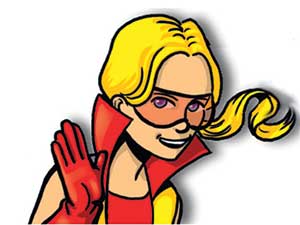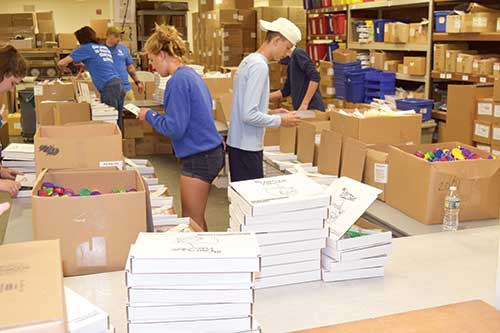By Leah Poffenberger
Every year at the end of August, a small army of high school students descends on the headquarters of Educational Innovations Inc. (EI) in Bethel, Connecticut for a box-packing extravaganza: Over three days, 20,000 cardboard containers are assembled, crammed with experimental materials, labeled, and shipped out to middle schools across the country. Thanks to the expertise of EI, the packing party runs like a well-oiled machine, but coming up with what goes inside the boxes takes some trial and error.
Creating innovative physics demonstration kits for under $20 to send to 20,000 physics classrooms is no easy feat. Thankfully, the dynamic duo of EI’s Ted Beyer and APS Head of Outreach Rebecca Thompson have the process down to a science.

Spectra
For 13 years, Thompson and Beyer have been collaborating on PhysicsQuest, the APS program that sends educational materials to middle school classrooms to inspire engagement in physics. Each activity that goes in a PhysicsQuest kit demonstrates a concept found in the accompanying Spectra comic books, which are written by Thompson, and make use of fairly easy to find parts. Beyer’s specialty is finding the right stuff at the best price.
“There’s usually a normal set of classroom activities that you can find—experiments everyone will talk about and everybody will see,” says Thompson. “You can't find the activities in PhysicsQuest kits anywhere else—these are all from scratch. It's taking an idea, some experiments people have done before, some classroom activities and totally redoing them in a way that makes them cheaper, or more accessible or way more instructive.”
To create these out-of-the-ordinary classroom activities, Thompson takes classroom concepts like diffraction or conductivity and comes up with ideas for experiments mostly using common things like wires or straws. Then it’s up to Beyer to find the materials at the best price, propose a better alternative, or sometimes send Thompson back to the drawing board.
“[Thompson] used to call me up and say ‘I want, or I need, or I have to have [a specific item] made,’” says Beyer. “Now she calls and says ‘I need something that has certain parameters’—there’s synergy between the two of us because we’ve worked together for so long.”
Beyer recalls Thompson calling him one day asking for individual butter packets to go inside the PhysicsQuest kits for a thermal conductivity experiment. Since butter would melt in the mail, likely ruining the rest of the kit, Beyer looked for a new solution: something easy to pack, inexpensive, and with a low melting point. Inspired by an M&Ms commercial, he decided on Hershey’s Kisses—chocolate would be more stable than butter but would still melt. The resulting experiment has the student put the candies on the tops of three different wires—aluminum, copper, and iron—and place the other end of each wire in a cup that would be filled with boiling water. The wires then conducted heat, melting the chocolates to slide down the wire—copper’s chocolate slid the most. Iron’s didn’t move at all.
Sometimes experiments aren’t possible because of available resources: An experiment to make optical lenses out of gelatin was scrapped because Jell-o is too expensive and a demo on the tribo-luminescence of quartz was impossible to include since quartz can’t be ordered as small portions to fit in a kit. But sometimes the back and forth to find just the right PhysicsQuest materials takes a humorous turn.
“[Thompson] called me up and said ‘I have one more thing I want to put into the kit—boiled eggs,’’ recalls Beyer. “I expended hours trying to figure out how I could get her hard-boiled eggs—until she called me the next morning to say she was kidding.”
The biggest factor that determines whether an activity or a material is usable for the PhysicsQuest kits is cost: Each kit is under $20, usually closer to $15, and half of that is shipping. It becomes a puzzle to determine what will work, and how the kits can be most cost effective.
“We’re cutting pennies to make this work,” says Beyer. “The spreadsheets I use to calculate how much each kit costs goes four digits beyond the decimal.”
Once the materials for the PhysicsQuest kits arrive, the precision continues into the packing and shipping. With more than two decades of experience supplying teachers with materials for classroom demonstrations, EI is the perfect PhysicsQuest partner.
“The effort that goes into making everything work is insane—it’s so organized,” says Thompson, who visited the EI headquarters in August to get in on the kit-packing action.
“Things don’t get mixed up—everybody gets what they ordered and what they ask for and what they need with everything in the boxes—nearly 20,000 kits get where they need to be.”
Putting together PhysicsQuest kits is a huge event with many moving parts, but for everyone at EI, it’s also something to be excited about.
“We look forward to PhysicsQuest every year—it’s hard work, but a lot of fun,” says Tami O’Connor, President of EI. “We always have such a sense of accomplishment when it’s finished—everyone is just delighted to be a part of PhysicsQuest.”
For more about the APS Physics Quest project, visit the Physics Central website.

High school students pack PhysicsQuest kits at Educational Innovations Inc. in Bethel, Connecticut.
©1995 - 2024, AMERICAN PHYSICAL SOCIETY
APS encourages the redistribution of the materials included in this newspaper provided that attribution to the source is noted and the materials are not truncated or changed.
Editor: David Voss
Staff Science Writer: Leah Poffenberger
Contributing Correspondent: Alaina G. Levine
Publication Designer and Production: Nancy Bennett-Karasik
October 2018 (Volume 27, Number 9)
Articles in this Issue

